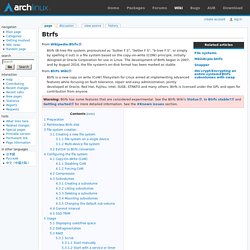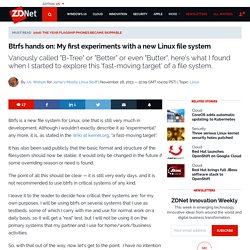

Btrfs. Btrfs is a new copy on write (CoW) filesystem for Linux aimed at implementing advanced features while focusing on fault tolerance, repair and easy administration.

Btrfs is under heavy development, but every effort is being made to keep the filesystem stable and fast. Because of the speed of development, running the latest possible Linux kernel is highly recommended. More Information on Btrfs is available at and Recent benchmarks are available here Features In Ubuntu 11.04 and later, the installer sets up btrfs with a specific layout: The default subvolume to mount is always the top of the btrfs tree (subvolid=5). Subvolumes are created below the top of the btrfs tree as needed, e.g. for / and /home, it creates subvolumes named @ and @home. The @ subvolume is mounted to / using the kernel boot option rootflags=subvol=@ The @home subvolume (if it is used), is mounted via the mount option subvol=@home in fstab. How to work with snaphots in Ubuntu's layout sudo mount /dev/sdX# /mnt Create snapshots. Btrfs Wiki. Btrfs - Wikipedia. Btrfs. Btrfs is a copy-on-write (CoW) filesystem for Linux aimed at implementing advanced features while focusing on fault tolerance, repair and easy administration.

Jointly developed at Oracle, Red Hat, Fujitsu, Intel, SUSE, STRATO and many others, Btrfs is licensed under the GPL and open for contribution from anyone. Features Ext4 is safe and stable and can handle large filesystems with extents, but why switch? While it is true that Btrfs is still considered experimental and is growing in stability, the time is nearing when Btrfs will become the default filesystem for Linux systems. Some Linux distributions have already begun to switch to it with their current releases.
Copy on Write (CoW) and snapshotting - Make incremental backups painless even from a "hot" filesystem or virtual machine (VM). For an up-to-date and somewhat exausting listing of features see the upstream wiki's status page. Btrfs. Translation(s): English - Русский FileSystem > Btrfs Btrfs was created to address the lack of pooling, snapshots, checksums, and integrated multi-device spanning in Linux file systems, particularly as the need for such features emerged when working at the petabyte scale.

It aspires to be a multipurpose filesystem that scales well from massive block devices all the way down to cellular phones (Sailfish OS and Android). Because all reads are checksum-verified, Btrfs takes care to ensure that your backups are not poisoned by silently corrupted source data—ZFS similarly ensures data integrity. History. Btrfs. From Wikipedia:Btrfs: Btrfs (B-tree file system, pronounced as "butter F S", "better F S", "b-tree F S", or simply by spelling it out) is a file system based on the copy-on-write (COW) principle, initially designed at Oracle Corporation for use in Linux.

The development of Btrfs began in 2007, and by August 2014, the file system's on-disk format has been marked as stable. From Btrfs Wiki: What Is Btrfs Filesystem (and Why Is It Better Than Ext4)? There is more to a hard drive than its size.

While the amount of disk space is all you see marketed about a hard drive on a sales page, there is actually an extensive amount of coding that goes into making a hard drive capable of handling your applications and data in the first place. Most Linux distributions currently default to using the ext4 file system, but the future for many of them lies with the B-tree file system, better known as Btrfs. To put it simply, a file system is how a hard drive is able to store, access, and manage files. While different operating systems can run off of the same hard drive, they tend not to share the same file system. Windows users rely on the New Technology File System (NTFS) while Mac OS X currently runs on the HFS+ file system. Btrfs hands on: My first experiments with a new Linux file system.
Btrfs is a new file system for Linux, one that is still very much in development.

Although I wouldn't exactly describe it as "experimental" any more, it is, as stated in the Wiki at kernel.org, "a fast-moving target". It has also been said publicly that the basic format and structure of the filesystem should now be stable; it would only be changed in the future if some overriding reason or need is found. The point of all this should be clear — it is still very early days, and it is not recommended to use btrfs in critical systems of any kind.
I leave it to the reader to decide how critical their systems are; for my own purposes, I will be using btrfs on several systems that I use as testbeds, some of which I carry with me and use for normal work on a daily basis, so it will get a "real" test, but I will not be using it on the primary systems that my partner and I use for home/work/business activities. So, with that out of the way, now let's get to the point.
Mkfs.btrfs /dev/sda16 Aha.